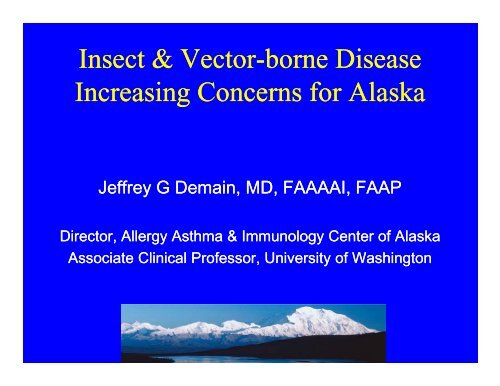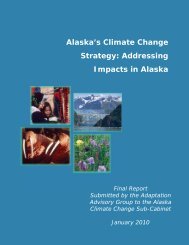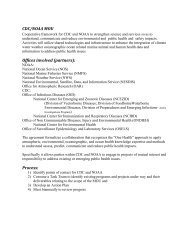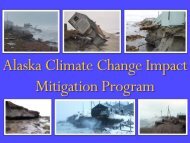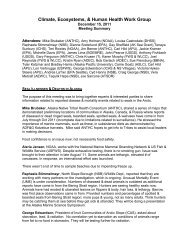Insect & Vector-borne Threats - Climate Change in Alaska
Insect & Vector-borne Threats - Climate Change in Alaska
Insect & Vector-borne Threats - Climate Change in Alaska
Create successful ePaper yourself
Turn your PDF publications into a flip-book with our unique Google optimized e-Paper software.
<strong>Insect</strong> & <strong>Vector</strong>-<strong>borne</strong><br />
Disease<br />
Increas<strong>in</strong>g Concerns for <strong>Alaska</strong><br />
Jeffrey G Dema<strong>in</strong>, MD, FAAAAI, FAAP<br />
Director, Allergy Asthma & Immunology Center of <strong>Alaska</strong><br />
Associate Cl<strong>in</strong>ical Professor, University of Wash<strong>in</strong>gton
Disclosures<br />
I am not an expert on the topic of global warm<strong>in</strong>g.<br />
• Research<br />
• Genentech<br />
• Novartis<br />
• CSL Behr<strong>in</strong>g<br />
• Speaker<br />
• Genentech<br />
• Novartis<br />
• Teva<br />
• Sanofi-Aventis<br />
• Astra-Zeneca<br />
I have no potential conflicts of <strong>in</strong>terest relevant to this topic.
Impact on Health<br />
<strong>in</strong> <strong>Alaska</strong><br />
Increased St<strong>in</strong>g<strong>in</strong>g and<br />
Bit<strong>in</strong>g <strong>Insect</strong>s<br />
Potential Risk of<br />
<strong>Vector</strong> Borne Disease
<strong>Vector</strong> <strong>borne</strong> diseases<br />
Arthropod <strong>borne</strong> viruses<br />
• Tick-<strong>borne</strong> Encephalitis<br />
• West Nile Virus<br />
• Northway Virus<br />
• Snowshoe hare Virus<br />
Emerg<strong>in</strong>g public health threats<br />
Emerg<strong>in</strong>g public health threats<br />
<strong>in</strong> the arctic regions of Canada,<br />
<strong>Alaska</strong> & the Russian<br />
Federation
<strong>Vector</strong> <strong>borne</strong> diseases<br />
Mosquitos that transmit<br />
WNV are present <strong>in</strong> the<br />
US and Canadian Arctic:<br />
- Aedes canadiensis<br />
- Aedes Vexans<br />
- Culex pipiens<br />
- Culex resuan<br />
Dead bird surveillance<br />
conducted 2000-2006 <strong>in</strong><br />
<strong>Alaska</strong> did not identify<br />
WNV<br />
57.5 o N<br />
Furthest north<br />
57.5 o Latitude N<br />
(2004)<br />
Adapted from Alan Park<strong>in</strong>son PhD, CDC, Arctic Investigations Program
Tick-<strong>borne</strong> Encephalitis (TBE)<br />
• Over the past 20 years there has been a<br />
substantial <strong>in</strong>crease <strong>in</strong> TBE <strong>in</strong> Sweden<br />
and shifts <strong>in</strong> northern latitude distribution.<br />
• This <strong>in</strong>crease has been l<strong>in</strong>ked to global<br />
warm<strong>in</strong>g and a change toward milder<br />
w<strong>in</strong>ters and earlier arrival of spr<strong>in</strong>g.<br />
• Increases <strong>in</strong> tick prevalence and <strong>in</strong>fection 59.26 N<br />
• Ixodes ric<strong>in</strong>us is the ma<strong>in</strong> vector for<br />
• Lyme borreliosis<br />
• Tick-<strong>borne</strong> encephalitis<br />
L<strong>in</strong>dgren E, Gustafson R. The Lancet, 2001;358:16-18
Tick-<strong>borne</strong> Encephalitis, Sweden<br />
Early<br />
1980s<br />
Mid‐<br />
1990s<br />
59.26 N 59.26 N<br />
Juneau is 58.18 N.<br />
L<strong>in</strong>dgren et al. 2000
Chang<strong>in</strong>g gPatterns<br />
of <strong>Insect</strong>s
Increas<strong>in</strong>g Hymenoptera<br />
<strong>in</strong> <strong>Alaska</strong><br />
• The number of hymenoptera <strong>in</strong> Fairbanks<br />
estimated to have <strong>in</strong>creased 10 fold <strong>in</strong> 2006*<br />
• Jack Whitman, a biologist with the<br />
Department t of Fish & Game**<br />
• Trapped 3,461 YJ on his property <strong>in</strong> a week<br />
• Used 3 homemade traps<br />
• Destroyed 9 aerial nests <strong>in</strong> three weeks<br />
• Estimated over 12,000 YJ<br />
• This pattern was similar throughout the state<br />
• <strong>Insect</strong>s adapt well to warmer temperature***<br />
*C ti ithD kSik PhD UAFE t l<br />
*Conversation with Derek Sikes, PhD, UAF Entomology<br />
**Mowry T, Fairbanks Daily M<strong>in</strong>er, Aug 13, 2006<br />
***Frazier M, et al, Am Nat 2006. 512-520
Hymenoptera Related<br />
Deaths <strong>in</strong> <strong>Alaska</strong><br />
• 2 deaths from hymenoptera st<strong>in</strong>gs <strong>in</strong><br />
Fairbanks dur<strong>in</strong>g the summer of 2006<br />
Dema<strong>in</strong>, J. G. & Gessner, B. D. Increas<strong>in</strong>g <strong>in</strong>cidence of medical visits due to<br />
<strong>in</strong>sect st<strong>in</strong>gs <strong>in</strong> <strong>Alaska</strong>. <strong>Alaska</strong> Epidemiology Bullet<strong>in</strong> 13 (2008)
Increase <strong>in</strong> ED visits for St<strong>in</strong>gs at<br />
Fairbanks Memorial<br />
St<strong>in</strong>gs <strong>in</strong> Fairbanks<br />
200<br />
180<br />
160<br />
140<br />
120<br />
# patients<br />
present<strong>in</strong>g to<br />
Fairbanks ED for<br />
st<strong>in</strong>g reaction<br />
100<br />
80<br />
60<br />
40<br />
20<br />
0<br />
1990<br />
1991<br />
1992<br />
1993<br />
1994<br />
1995<br />
1996<br />
1997<br />
1998<br />
1999<br />
2000<br />
2001<br />
2002<br />
2003<br />
2004<br />
2005<br />
2006<br />
Dema<strong>in</strong>, J, Gessner, B, McLaughl<strong>in</strong> J, Sikes,D, Foote,T . Allergy & Asthma Proceed<strong>in</strong>gs,2009. <strong>in</strong> press<br />
Trend
Venom Reactions<br />
Patients Referred to<br />
25<br />
Patients<br />
AAIC for Evaluation<br />
20<br />
of St<strong>in</strong>g Reactions<br />
15<br />
10<br />
5<br />
0<br />
1999 2000 2001 2002 2003 2004 2005 2006 2007<br />
ses<br />
Number of Ca<br />
25<br />
20<br />
15<br />
10<br />
5<br />
y = 2.35x - 4693.5<br />
R 2 = 0.8491; p
Increase <strong>in</strong> Medical Visits for St<strong>in</strong>gs Among<br />
<strong>Alaska</strong> Medicaid id Recipients i (0ver 132,000)<br />
ears<br />
Rate<br />
p er 1000 0 p erson-y<br />
9.0<br />
8.0<br />
70 7.0<br />
6.0<br />
5.0<br />
4.0<br />
3.0<br />
2.0<br />
1.0<br />
0.0<br />
1999 2000 2001 2002 2003 2004 2005 2006<br />
Any diagnosis<br />
Primary diagnosis<br />
Any diagnosis, unique events<br />
L<strong>in</strong>ear (Any diagnosis)<br />
Chi-Square S p
Does temperature change<br />
correlate with chang<strong>in</strong>g<br />
patterns of hymenoptera ?<br />
200<br />
180<br />
160<br />
140<br />
120<br />
100<br />
80<br />
St<strong>in</strong>gs <strong>in</strong> Fairbanks<br />
# patients<br />
present<strong>in</strong>g to<br />
Fairbanks ED for<br />
st<strong>in</strong>g reaction<br />
Trend<br />
60<br />
40<br />
20<br />
0<br />
1990<br />
90<br />
1991 91<br />
1992 92<br />
199393<br />
199494<br />
199595<br />
199696<br />
199797<br />
1998 98<br />
1999<br />
2000<br />
2001 01<br />
200202<br />
200303<br />
200404<br />
200505<br />
200606<br />
9.0<br />
[5]<br />
Tanana Valley Cl<strong>in</strong>ic, Department of Pediatrics, Fairbanks<br />
e ars<br />
e p er 1000 p erson-ye<br />
Rate<br />
8.0<br />
7.0<br />
6.0<br />
5.0<br />
4.0<br />
3.0<br />
2.0<br />
1.0<br />
0.0<br />
1999 2000 2001 2002 2003 2004 2005 2006<br />
Any diagnosis<br />
Primary diagnosis<br />
Any diagnosis, unique events<br />
25<br />
20<br />
15<br />
10<br />
Patients<br />
5<br />
0<br />
1999 2000 2001 2002 2003 2004 2005 2006 2007<br />
Dema<strong>in</strong>, J, Gessner, B, McLaughl<strong>in</strong> J, Sikes,D, Foote,T . Allergy & Asthma Proceed<strong>in</strong>gs,2009. <strong>in</strong> press
Epidemiologic Regions of <strong>Alaska</strong><br />
Northern<br />
http://climate.gi.alaska.edu/ClimTrends/<strong>Change</strong>/Temp<strong>Change</strong>.html<br />
alaska edu/ClimTrends/<strong>Change</strong>/Temp<strong>Change</strong> html<br />
Interior<br />
Anchorage/Mat-Su<br />
Southwest<br />
Gulf Coast<br />
Southeast
Annual<br />
W<strong>in</strong>ter<br />
1999-2001<br />
2004-2006<br />
Percent change <strong>in</strong> <strong>in</strong>sect<br />
Largest<br />
temperature<br />
temperature<br />
<strong>in</strong>sect st<strong>in</strong>g<br />
<strong>in</strong>sect st<strong>in</strong>g<br />
st<strong>in</strong>g <strong>in</strong>cidence (Х 2 for<br />
Region Community Increase* Increase* <strong>in</strong>cidence † <strong>in</strong>cidence † trend, p-value) ‡<br />
Northern Barrow 3.8 6.1 16 119 626% (13, p
Annual<br />
W<strong>in</strong>ter<br />
1999-2001<br />
2004-2006<br />
Percent change <strong>in</strong> <strong>in</strong>sect<br />
Largest<br />
temperature<br />
temperature<br />
<strong>in</strong>sect st<strong>in</strong>g<br />
<strong>in</strong>sect st<strong>in</strong>g<br />
st<strong>in</strong>g <strong>in</strong>cidence (Х 2 for<br />
Region Community Increase* Increase* <strong>in</strong>cidence † <strong>in</strong>cidence † trend, p-value) ‡<br />
Northern Barrow 3.8 6.1 16 119 626% (13, p
Annual<br />
W<strong>in</strong>ter<br />
1999-2001<br />
2004-2006<br />
Percent change <strong>in</strong> <strong>in</strong>sect<br />
Largest<br />
temperature<br />
temperature<br />
<strong>in</strong>sect st<strong>in</strong>g<br />
<strong>in</strong>sect st<strong>in</strong>g<br />
st<strong>in</strong>g <strong>in</strong>cidence (Х 2 for<br />
Region Community Increase* Increase* <strong>in</strong>cidence † <strong>in</strong>cidence † trend, p-value) ‡<br />
Northern Barrow 3.8 6.1 16 119 626% (13, p
Annual<br />
W<strong>in</strong>ter<br />
1999-2001<br />
2004-2006<br />
Percent change <strong>in</strong> <strong>in</strong>sect<br />
Largest<br />
temperature<br />
temperature<br />
<strong>in</strong>sect st<strong>in</strong>g<br />
<strong>in</strong>sect st<strong>in</strong>g<br />
st<strong>in</strong>g <strong>in</strong>cidence (Х 2 for<br />
Region Community Increase* Increase* <strong>in</strong>cidence † <strong>in</strong>cidence † trend, p-value) ‡<br />
Northern Barrow 3.8 6.1 16 119 626% (13, p
Annual<br />
W<strong>in</strong>ter<br />
1999-2001<br />
2004-2006<br />
Percent change <strong>in</strong> <strong>in</strong>sect<br />
Largest<br />
temperature<br />
temperature<br />
<strong>in</strong>sect st<strong>in</strong>g<br />
<strong>in</strong>sect st<strong>in</strong>g<br />
st<strong>in</strong>g <strong>in</strong>cidence (Х 2 for<br />
Region Community Increase* Increase* <strong>in</strong>cidence † <strong>in</strong>cidence † trend, p-value) ‡<br />
Northern Barrow 3.8 6.1 16 119 626% (13, p
Annual<br />
W<strong>in</strong>ter<br />
1999-2001<br />
2004-2006<br />
Percent change <strong>in</strong> <strong>in</strong>sect<br />
Largest<br />
temperature<br />
temperature<br />
<strong>in</strong>sect st<strong>in</strong>g<br />
<strong>in</strong>sect st<strong>in</strong>g<br />
st<strong>in</strong>g <strong>in</strong>cidence (Х 2 for<br />
Region Community Increase* Increase* <strong>in</strong>cidence † <strong>in</strong>cidence † trend, p-value) ‡<br />
Northern Barrow 3.8 6.1 16 119 626% (13, p
Annual<br />
W<strong>in</strong>ter<br />
1999-2001<br />
2004-2006<br />
Percent change <strong>in</strong> <strong>in</strong>sect<br />
Largest<br />
temperature<br />
temperature<br />
<strong>in</strong>sect st<strong>in</strong>g<br />
<strong>in</strong>sect st<strong>in</strong>g<br />
st<strong>in</strong>g <strong>in</strong>cidence (Х 2 for<br />
Region Community Increase* Increase* <strong>in</strong>cidence † <strong>in</strong>cidence † trend, p-value) ‡<br />
Northern Barrow 3.8 6.1 16 119 626% (13, p
Annual<br />
W<strong>in</strong>ter<br />
1999-2001<br />
2004-2006<br />
Percent change <strong>in</strong> <strong>in</strong>sect<br />
Largest<br />
temperature<br />
temperature<br />
<strong>in</strong>sect st<strong>in</strong>g<br />
<strong>in</strong>sect st<strong>in</strong>g<br />
st<strong>in</strong>g <strong>in</strong>cidence (Х 2 for<br />
Region Community Increase* Increase* <strong>in</strong>cidence † <strong>in</strong>cidence † trend, p-value) ‡<br />
Northern Barrow 3.8 6.1 16 119 626% (13, p
Annual<br />
W<strong>in</strong>ter<br />
1999-2001<br />
2004-2006<br />
Percent change <strong>in</strong> <strong>in</strong>sect<br />
Largest<br />
temperature<br />
temperature<br />
<strong>in</strong>sect st<strong>in</strong>g<br />
<strong>in</strong>sect st<strong>in</strong>g<br />
st<strong>in</strong>g <strong>in</strong>cidence (Х 2 for<br />
Region Community Increase* Increase* <strong>in</strong>cidence † <strong>in</strong>cidence † trend, p-value) ‡<br />
Northern Barrow 3.8 6.1 16 119 626% (13, p
Results<br />
• Each of the three databases revealed an <strong>in</strong>creas<strong>in</strong>g trend for<br />
patients t seek<strong>in</strong>g medical care for bites & st<strong>in</strong>gs (p
Distribution or Survival<br />
of <strong>Insect</strong>s<br />
• Arthropods are extremely temperature sensitive<br />
• <strong>Climate</strong> changes have impacted life cycles and<br />
expanded <strong>in</strong>habitable territory<br />
• Mosquitoes and plant communities are migrat<strong>in</strong>g to<br />
higher ground as permafrost thaws and glaciers retreat<br />
• Beetle plagued forests <strong>in</strong> <strong>Alaska</strong> have impacted over<br />
4,000,000 acres<br />
• Lepidoptera are expand<strong>in</strong>g their northern boundaries <strong>in</strong><br />
the northern hemisphere<br />
• Ticks (Ixodes ric<strong>in</strong>us) that transmit Lyme borreliosis and<br />
viral encephalitis have extended northwards <strong>in</strong> Sweden<br />
associated with fewer w<strong>in</strong>ter days below 10 degrees<br />
and more summer days above 50 degrees
<strong>Climate</strong> <strong>Change</strong> and <strong>Insect</strong>s <strong>in</strong> the Arctic<br />
• The average Arctic temperature<br />
have <strong>in</strong>creased at almost twice<br />
the rate of the rest of the world <strong>in</strong><br />
the past two decades the Arctic<br />
may serve as a sent<strong>in</strong>el site for<br />
early detection of changes <strong>in</strong> the<br />
epidemiology of <strong>in</strong>fectious<br />
diseases due to climate change
The Arctic:<br />
Our W<strong>in</strong>dow to the Future?


